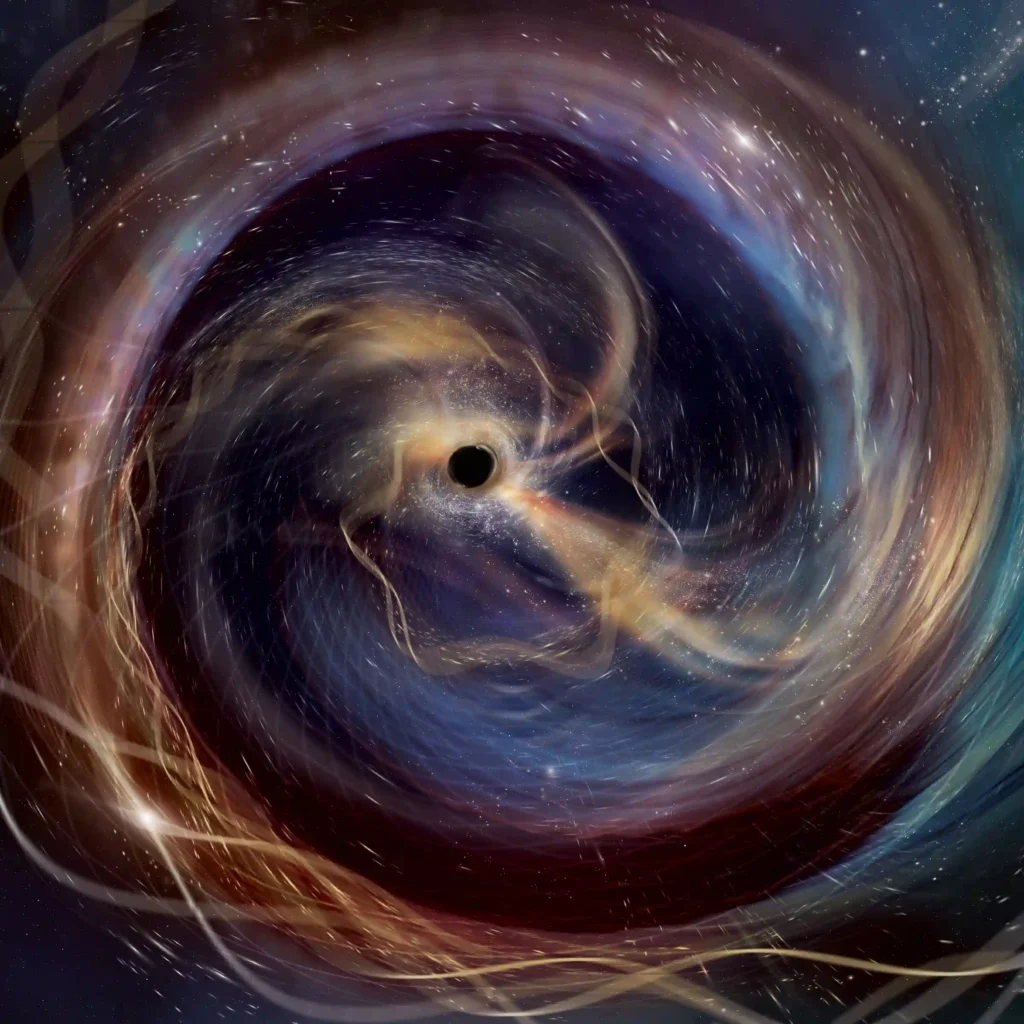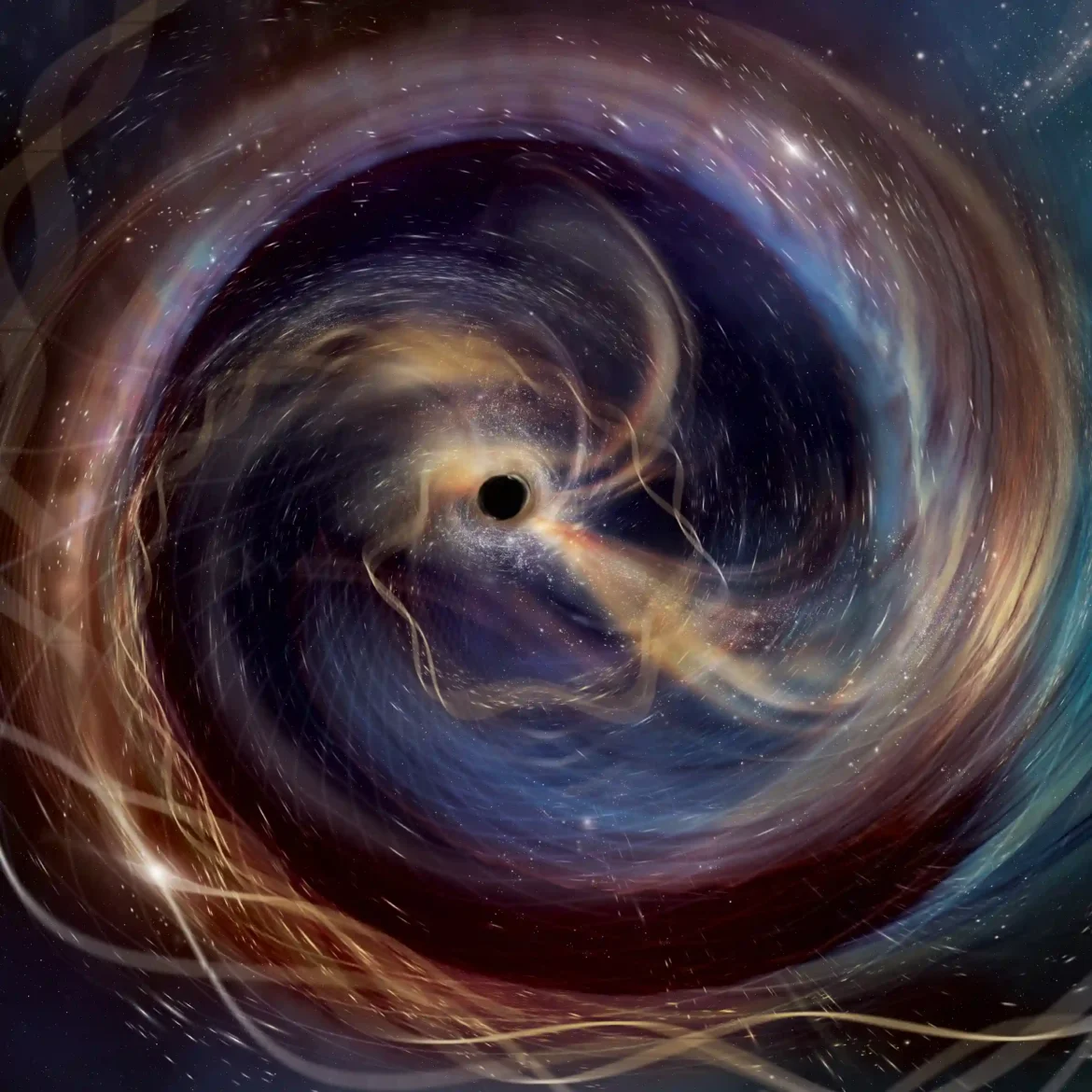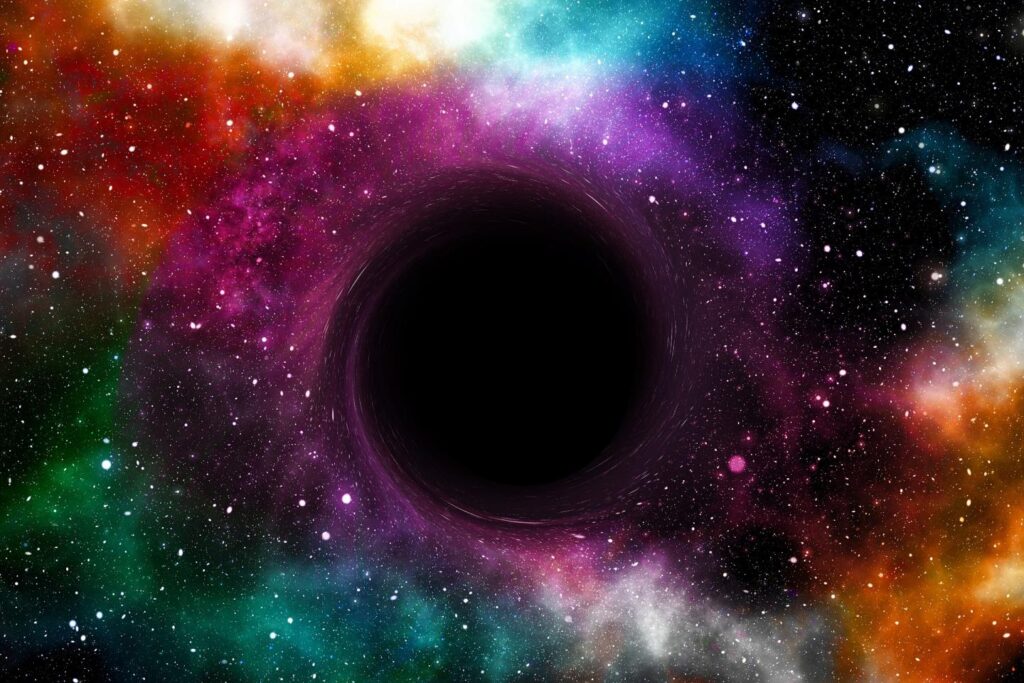LVK: ten years after the discovery, gravitational waves verify Stephen Hawking’s Black Hole Area Theorem
LIGO, Virgo and KAGRA celebrate the anniversary of the first gravitational waves detection and announce verification of Stephen Hawking’s Black Hole Area Theorem.
On September 14, 2015, a signal arrived on Earth, carrying information about a pair of remote black holes that had spiraled together and merged. The signal had traveled about 1.3 billion years to reach us at the speed of light—but it was not made of light. It was a different kind of signal: a quivering of space-time called gravitational waves, first predicted by Albert Einstein 100 years prior. On that day 10 years ago, the twin detectors of the Laser Interferometer Gravitational-Wave Observatory (LIGO) made the first-ever direct detection of gravitational waves. The LIGO and Virgo collaborations announced it to the world in February 2016, after six months of analysis and verification.
The historic discovery meant that researchers could now sense the universe through three different means. Light waves, such as X-rays, optical, radio, and other wavelengths of light, as well as high-energy particles called cosmic rays and neutrinos had been captured before, but this was the first time researchers had witnessed a cosmic event through its gravitational warping of space-time. For this achievement, first dreamed up more than 40 years prior, three of the LIGO founders won the 2017 Nobel Prize in Physics: MIT’s Rainer Weiss, professor of physics, emeritus (who recently passed away at age 92); Caltech’s Barry Barish; and Caltech’s Kip Thorne.

This chart plots discoveries made by the LIGO-Virgo-KAGRA (LVK) network since LIGO’s first detection, in 2015, of gravitational waves emanating from a pair of colliding black holes. The detections consist mainly of black hole mergers, but a handful involve neutron stars (either black hole-neutron star collisions or neutron star-neutron star collisions).
So far, during the current, fourth science run, the LVK detectors have spotted about 220 mergers, which more than doubles the number (90) found in the first three runs combined. The closest event observed to date, shown in Run 2 and indicated by the down arrow, is a binary neutron star merger known as GW170817, located only 0.13 gigalight-years away (or 130 million light-years).
In this chart, the total masses of the initial objects are represented by size, while the signal strength is indicated by color. The plot demonstrates that over time the gravitational-wave observatories are both finding more black holes and detecting them with higher signal-to-noise ratios, thanks to cutting-edge advancements made to the detectors.
Note that the black hole detections in the latter half of the fourth run are grey and appear to be the same size because these data have not been released in full—with the exception of the event called GW250114. That event, the clearest signal heard by LIGO yet, appears as a bright, orange dot on the chart in the fourth run. Image credits: LIGO/Caltech/MIT/R. Hurt (IPAC)
LIGO, which consists of detectors in both Hanford, Washington and Livingston, Louisiana, the Virgo detector in Italy and KAGRA in Japan operate in coordination and currently are routinely observing roughly one black hole merger every three days. Together, the gravitational-wave-hunting network, known as LVK (LIGO, Virgo, KAGRA), has captured a total of more than 300 black hole mergers, most of which are already confirmed while others await further analysis. During the network’s current science run, the fourth since the first run in 2015, the LVK has discovered about 230 candidate black hole mergers, more than doubling the number caught in the first three runs.
The dramatic rise in the number of LVK discoveries over the past decade is owed to several improvements to their detectors—some of which involve cutting-edge quantum precision engineering. These gravitational-wave interferometers remain by far the most precise rulers for making measurements ever created by humans. The space-time distortions induced by gravitational waves are incredibly minuscule. To sense them, LIGO and Virgo must detect changes in space-time smaller than 1/10,000 the width of a proton. That’s 700 trillion times smaller than the width of a human hair.
The Clearest Signal Yet
The improved sensitivity of the instruments is exemplified in a recent discovery of a black hole merger referred to as GW250114 (the numbers denote the date the gravitational-wave signal arrived at Earth: January 14, 2025). The event was not that different from the first-ever detection (called GW150914)—both involve colliding black holes about 1.3 billion light-years away with masses between 30 to 40 times that of our Sun. But thanks to 10 years of technological advances reducing instrumental noise, the GW250114 signal is dramatically clearer.
“We can hear it loud and clear, and that lets us test the fundamental laws of physics,”
says LIGO team member Katerina Chatziioannou, Caltech assistant professor of physics and William H. Hurt Scholar, and one of the leading authors of a new study on GW250114 published in the Physical Review Letters.
By analyzing the frequencies of gravitational waves emitted by the merger, the LVK team was able to provide the best observational evidence captured to date for what is known as the black hole area theorem, an idea put forth by Stephen Hawking in 1971 that says the total surface areas of black holes cannot decrease. When black holes merge, their masses combine, increasing the surface area. But they also lose energy in the form of gravitational waves during the phenomenon. Additionally, the merger can cause the combined black hole to increase its spin, which leads to it having a smaller area. The black hole area theorem states that, despite these competing factors, the total surface area must grow in size.
Later, Hawking and physicist Jacob Bekenstein concluded that a black hole’s area is proportional to its entropy, or degree of disorder. The findings paved the way for later groundbreaking work in the field of quantum gravity, which attempts to unite two pillars of modern physics: general relativity and quantum physics.

In essence, the detection (made just by LIGO, since Virgo was undergoing routine maintenance and KAGRA was offline during this particular observation) allowed the team to “hear” two black holes growing as they merged into one, verifying Hawking’s theorem. The initial black holes had a total surface area of 240,000 square kilometers (roughly the size of United Kingdom), while the final area was about 400,000 square kilometers (almost the size of Sweden)—a clear increase. This is the second test of the black hole area theorem; an initial test was performed in 2021 using data from the first GW150914 signal, but because that data was not as clean, the results had a confidence level of 95 percent as compared to 99.999 percent for the new data. Kip Thorne recalls Hawking phoning him to ask whether LIGO might be able to test his theorem immediately after he learned of the 2015 gravitational-wave detection. Hawking died in 2018 and sadly did not live to see his theory observationally verified.
“If Hawking were alive, he would have reveled in seeing the area of the merged black holes increase,” Thorne says.
The trickiest part of this type of analysis had to do with determining the final surface area of the merged black hole. The surface areas of pre-merger black holes can be more readily gleaned as the pair spiral together, roiling space-time and producing gravitational waves. But after the black holes merge, the signal is not as clearcut. During this so-called ringdown phase, the final black hole vibrates like a struck bell.

In the new study, the researchers were able to precisely measure the details of the ringdown phase, which allowed them to calculate the mass and spin of the black hole, and subsequently determine its surface area. More precisely, they were able, for the first time, to confidently pick out two distinct gravitational-wave modes in the ringdown phase. The modes are like characteristic sounds a bell would make when struck; they have somewhat similar frequencies but die out at different rates, which makes them hard to identify. The improved data for GW250114 meant that the team could extract the modes, demonstrating that the black hole’s ringdown occurred exactly as predicted by math models Another study from the LVK, submitted to Physical Review Letters today, places limits on a predicted third, higher-pitch tone in the GW250114 signal, and performs some of the most stringent tests yet of general relativity’s accuracy in describing merging black holes.
“Analyzing strain data from the detectors to detect transient astrophysical signals, send out alerts to trigger follow-up observations from telescopes or publish physics results gathering information from up to hundreds of events is quite a long journey – adds Nicolas Arnaud, CNRS researcher in France and Virgo coordinator of the fourth science run – Out of the many skilled steps that such a complex framework requires, I see the humans behind all these data, in particular those who are on duty at any time, watching over our instruments. There are LVK scientists in all regions, pursuing a common goal: literally, the Sun never goes down above our collaborations!”
Pushing the limits
LIGO and Virgo have also unveiled neutron stars over the past decade. Like black holes, neutron stars form the explosive deaths of massive stars, but they weigh less and glow with light. Of note, in August of 2017, LIGO and Virgo witnessed an epic collision between a pair of neutron stars—a kilonova—that sent gold and other heavy elements flying into space and drew the gaze of dozens of telescopes around the world, which captured light ranging from high-energy gamma rays to low-energy radio waves. The “multi-messenger” astronomy event marked the first time that both light and gravitational waves had been captured in a single cosmic event. Today, the LVK continues to alert the astronomical community to potential neutron star collisions, who then use telescopes to search the skies for signs of another kilonova.
“The global LVK network is essential to gravitational-wave astronomy,” says Gianluca Gemme, Virgo spokesperson and director of research at INFN (Istituto Nazionale di Fisica Nucleare). “With three or more detectors operating in unison, we can pinpoint cosmic events with greater accuracy, extract richer astrophysical information, and enable rapid alerts for multi-messenger follow-up. Virgo is proud to contribute to this worldwide scientific endeavor.”
Other LVK scientific discoveries include the first detection of collisions between one neutron star and one black hole; asymmetrical mergers, in which one black hole is significantly more massive than its partner neutron star; the discovery of the lightest black holes known, challenging the idea that there is a “mass gap” between neutron stars and black holes; and the most massive black hole merger seen yet with a merged mass of 225 solar masses. For reference, the previous record-holder for the most massive merger had a combined mass of 140 solar masses.
In the coming years, the scientists of LVK hope to further fine tune their machines, expanding their reach deeper and deeper into space. They also plan to use the knowledge they have gained to build another gravitational-wave detector, LIGO India. Looking farther into the future, scientists are working on a concept for even larger detectors.The European project, called Einstein Telescope, plans to build one or two huge underground interferometers with arms of more than 10 kilometers, The US one, called Cosmic Explorer, would be similar to the current LIGO but with arms 40 kilometers long. Observatories on this scale would allow scientists to hear the earliest black hole mergers in the universe and, possibly, the echo of the gravitational shakes of the very first moments of our universe.
“This is an amazing time for gravitational wave research: thanks to instruments such as Virgo, LIGO and KAGRA, we can explore a dark universe that was previously completely inaccessible. – said Massimo Carpinelli, professor at University of Milano Bicocca and director of the European Gravitational Observatory in Cascina – The scientific achievements of these 10 years are triggering a real revolution in our view of the Universe. We are already preparing a new generation of detectors such as the Einstein Telescope in Europe and Cosmic Explorer in the US, as well as the LISA space interferometer, which will take us even further into space and back in time. In the coming years, we will certainly be able to tackle these extraordinary challenges thanks to increasingly broad and solid cooperation between scientists, different countries and institutions, both at European and global level.”

This artwork imagines the ultimate front-row seat for GW250114, a powerful collision between two black holes observed in gravitational waves by the US National Science Foundation LIGO. It depicts the view from one of the black holes as it spirals toward its cosmic partner. Ten years after LIGO’s landmark detection of gravitational waves, the observatory’s improved detectors allowed it to “hear” this celestial collision with unprecedented clarity. The gravitational-wave data enabled scientists to distinguish multiple subtle tones ringing out like a cosmic bell across the universe (imagined here as intertwining musical threads spiraling toward the center).
Though only LIGO was online during GW250114, it now routinely operates as part of a network with other gravitational-wave detectors, including Europe’s Virgo and Japan’s KAGRA.
Image credit: Aurore Simonnet (SSU/EdEon)/LVK/URI
Press release from EGO and Virgo






